Pump Handbook by Igor J. Karassik, Joseph P. Messina, Paul Cooper, Charles C. Heald - 3rd edition
Подождите немного. Документ загружается.

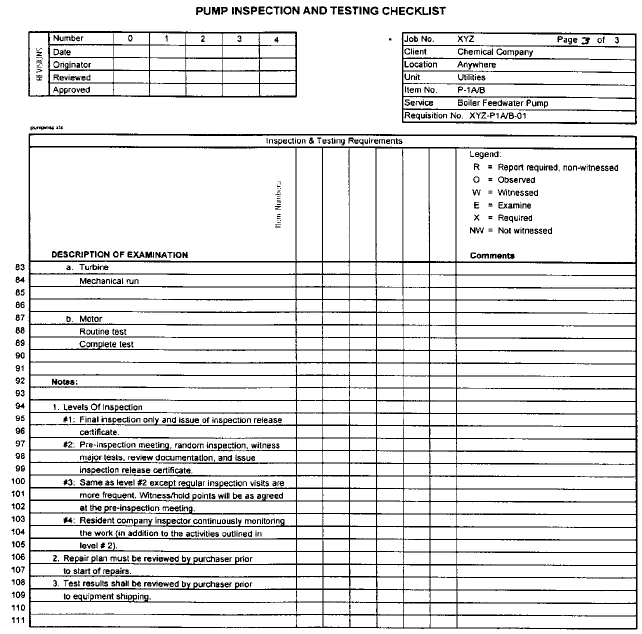
11.22 CHAPTER ELEVEN
FIGURE 6C Typical inspection and testing documents, page 3 of 3
If a proposed vendor is not known to the purchaser, a shop survey may be required to
satisfy the purchaser of a potential supplier’s ability. This type of survey will usually
include an inspection and assessment of the manufacturer’s shops, engineering and design
facility, and quality assurance organization.The complexity of the required equipment and
the project needs will determine the level of qualification required of the vendors. Remem-
ber that a vendor is required to provide not only the specified equipment, but also civil,
piping, and electrical interface information required for project design.A vendor must pos-
sess the skills necessary to support all of these requirements.
The number of vendors that are to receive bid requests is usually between three and
five. This number will provide for effective competition and will limit the quantity of
quotes that require evaluation.
Pump alliance agreements, or the need to duplicate existing equipment, may reduce
the list to a single bidder. In addition, unique design or vendor experience may dictate a
sole source supplier.
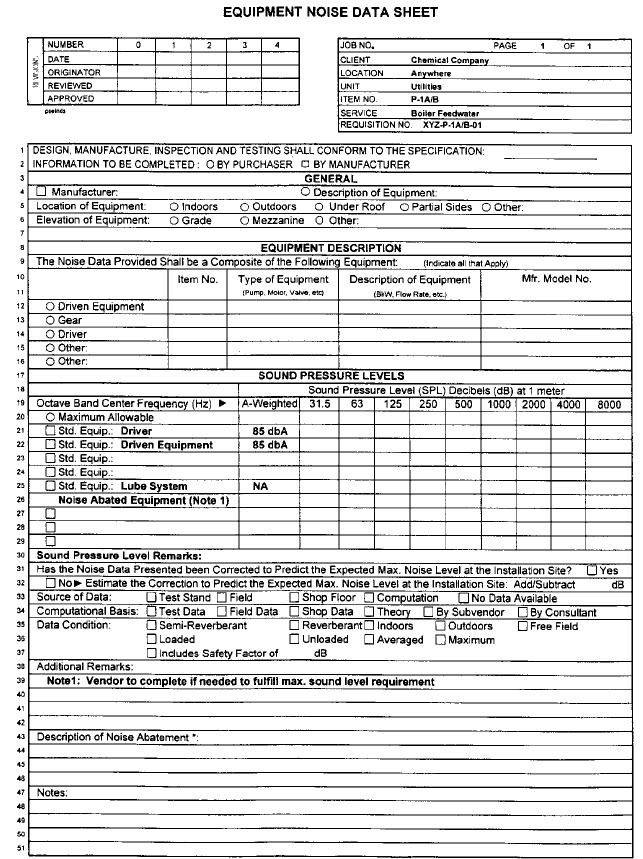
11 SELECTING AND PURCHASING PUMPS 11.23
FIGURE 7 Typical noise data sheet
Bidding Time The time required to prepare a bid will depend on the complexity of the
equipment, the relative cost of buy-out items (such as exotic castings and turbine drivers),
and the level of business activity in the market. It also depends on the number of pump
services included in the requisition. The more sub-vendors the main equipment supplier
must depend on, the longer the time needed for the vendor to provide an accurate quote.

11.24 CHAPTER ELEVEN
As a guideline, the following timing may be used to set the bid due date.
Often a vendor may have several bids due at approximately the same time. For this
and other reasons, vendors may ask that the bid due date be extended. Extensions can be
granted if the project schedule allows for this extra time.
It is in the interest of the purchaser to be flexible on bidding time limits to avoid los-
ing a potentially favorable bid. If a bid is extended, all bidders should be notified of the
extension so the additional time can be used to improve all quotes.
In many cases, it may not be acceptable to extend a bid due date. If a project schedule
is tight, timing may not allow for an extension. In the case of many public sector bids, bid
openings are advertised long in advance and may not be extended for this reason.
Pre-Bid Meeting If the required equipment is for a complex or difficult service, or if proj-
ect timing is such that the purchasing cycle must be minimized, a pre-bid meeting may
be of benefit. This meeting should be held after the vendors have read the inquiry but
before quote preparation has begun. During this meeting, the full range of requirements
are reviewed and emphasized when necessary. Areas of compromise may be suggested. At
this time, the vendor is free to ask questions and determine if alternatives to the speci-
fied equipment might be advantageous. If specification errors or oversights are noted dur-
ing these meetings, all bidders must be quickly informed.
The chances of obtaining quotes that are usable without major upgrading are much
more likely after a pre-bid meeting. This meeting might prevent a full re-bidding process
that might be necessary if vendors misinterpret requirements or are not able to offer
equipment in accordance with the inquiry.
Evaluation of Bids After the bid requisition has been prepared and sent to the
approved pump vendors for quotation, it is time to start preparing bid review documents.
Both commercial and technical evaluations will be necessary and can be accomplished on
the same or separate documents.
Review Strategies Review strategies differ between projects and clients. Often, tech-
nical reviewers are not made aware of the quoted costs and are concerned only with tech-
nical specification compliance and scope of supply. In this case, the commercial evaluation
is done by others. The final comparison of costs can be made after the various vendors
quotes are conditioned to meet all technical requirements. If the cost is withheld from the
technical reviewer, an important piece of evaluating information is missing, which
increases the chance of missing key requirements. Based on a quick comparison of cost,
it is easy for the document reviewer to establish the quoted general scope for each ven-
dor. If large cost differences are noted between vendors, the reviewer must carefully deter-
mine what major differences in quoted scope likely exist.
The number of quotes that will be fully evaluated will depend partly on the number
received. The goal is to ensure that the least expensive, technically acceptable bidder can
be determined while also minimizing evaluation hours.
Short Listing of Quotes When bids are first received, a quick commercial and techni-
cal tabulation is often prepared that lists the main scope of supply, extent of specification
compliance, major deviations, and the associated total cost. This is done to get a general
Bid Preparation Time
Application Weeks Required
Pre-engineered and conventional pumps
—
6 in
(152 mm) discharge and smaller 2
—
3
Pumps with 8 in to 48 in (203 to 1219 mm) discharge 3
—
4
Larger pumps or multiple pump requisitions 4
—
6
11 SELECTING AND PURCHASING PUMPS 11.25
idea of the completeness of the quotes as well as to provide information to determine
which of the quotes will be fully evaluated.
Technical Bid Evaluation Quotations must be evaluated against the specified require-
ments. Avoid a temptation to conditions bids so they are apples to apples. Comparing
apples to oranges is acceptable providing that specified requirements are met. Profes-
sional ethics prohibit giving a vendor’s better idea to competitors. A vendor should be
encouraged to use ingenuity when preparing a quotation. One vendor’s ingenuity should
never be shopped around to the others.
After the decision is made on which bids to fully evaluate, the formal review and con-
ditioning process can begin. A technical bid tabulation form is necessary to ensure that
the equipment is provided in compliance with the requisition. This tabulation will list
the important points of each vendor quote in table form. Each quote is then compared
line by line.
Items that are usually contained in a technical bid tab include
• Equipment model number and size
• Compliance with process duty requirements (flow, head, NPSHR, and so on)
• Mechanical design limitations (pressure and temperature)
• Mechanical and hydraulic operating parameters (such as brake horsepower, head rise to
shutoff, capacity rise to run out, percentage of best efficiency point)
• Mechanical design features (such as materials of construction, seal type, seal flush type,
bearing and lubrication type)
When the technical bid evaluation form is being completed, the reviewer must high-
light all items that do not meet requisition requirements or that are not clearly defined in
the vendor’s quote. In addition, features of the vendor’s quotation should be highlighted to
clearly indicate advantages, disadvantages, ambiguities, and non-compliances. A typical
API-610 pump technical bid evaluation is shown in Figures 8a to 8c.
Technical Quote Clarification Questions When the initial review is complete, a list
of clarification questions needs to be prepared and sent to each vendor being evaluated.
Questions should be direct and concise to ensure that responses answer the questions
asked. The vendors must be encouraged to provide cost adders, if necessary, to meet req-
uisition requirements. It is usually appropriate to allow the vendors one week to reply.
When answers to the clarification questions are received, the bid tabulation must be
updated to include any revisions in the vendors quotation. Care must be exercised in
tracking revisions to the original quotation. If additional clarification is needed, there are
various ways to go about it, depending on the situation. Some suggestions are detailed in
the following sections.
Telephone Inquiry This method should be discouraged in all but the simplest cases. If
used, notes of the telephone conversation must be recorded and filed for later reference.
The applicable portion of the vendor quotation should be marked to reflect any changes,
with proper reference made to where and why the changes were made.The vendor should
confirm all answers in writing, even to verbal questions. Good documentation is neces-
sary to clarify any future misunderstandings either before or after a purchase order is
placed.
E-mailed and Faxed Questions and Answers It is preferable that questions be asked
and answered by e-mail or fax. This will provide a positive information trail and can be
as timely as a telephone conversation. Each vendor will require approximately one week
to reply to this second round of questions.
Vendor Clarification Meeting Many factors will be used to determine if a vendor clar-
ification meeting is necessary. Is the potential value of the order high enough to justify
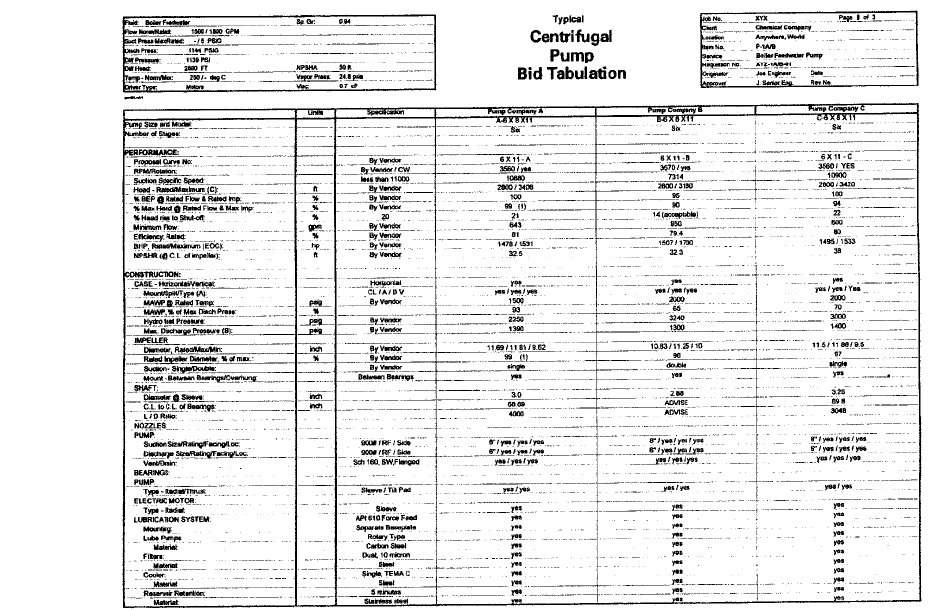
11.26
FIGURE 8A Typical API 610 technical bid evaluation, page 1 of 3
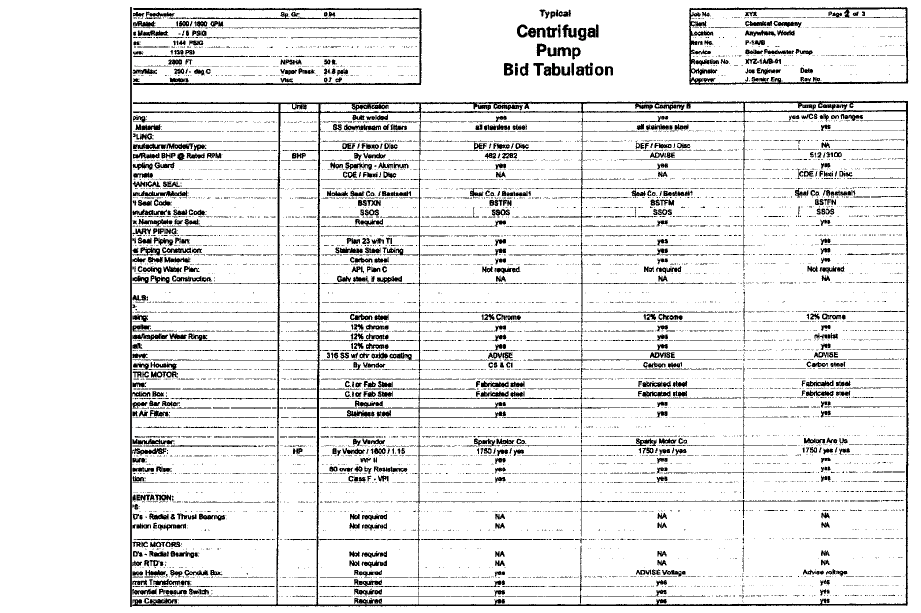
11.27
FIGURE 8B Typical API 610 technical bid evaluation, page 2 of 3
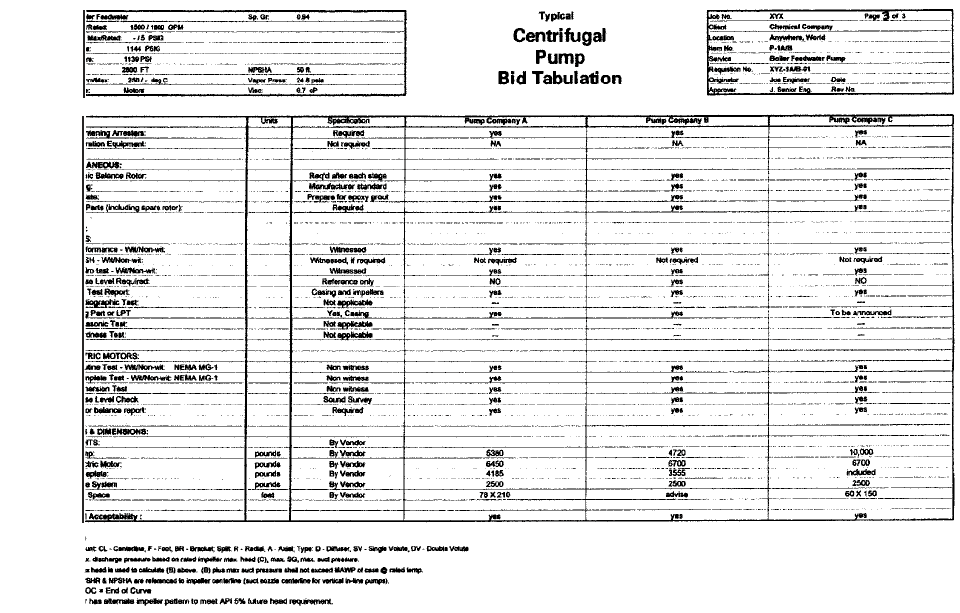
11.28
FIGURE 8C Typical API 610 technical bid evaluation, page 3 of 3
11 SELECTING AND PURCHASING PUMPS 11.29
the vendor’s (or purchaser’s) expenses associated with the meeting? Is the equipment suf-
ficiently complex to warrant a face to face meeting to ensure full understanding between
the vendor and purchaser? Is timing so critical that this method needs to be used to accel-
erate the clarification process?
As with any vendor communications, it is important to precisely minute all discussions
during the meeting.The vendor and purchaser must both agree on the content and action
items that have been noted. Agreements with commercial impact should be confirmed in
writing by the vendor. Action items should be assigned to a specific individual with an
agreed-upon closure date for each item.
Commercial Evaluation During Technical Evaluation Prior to completion of the tech-
nical evaluation, certain commercial items can be reviewed and negotiated with the ven-
dors being evaluated. Terms and conditions of payment, guarantee/warranty, and proposed
delivery schedule can usually be discussed in parallel with the technical conditioning of
the bids.
Technical Purchase Recommendation When all issues of bid requisition non-com-
pliance have been satisfactorily addressed, the engineer must recommend which vendor
or vendors may be considered for purchase of the required pump. Usually, part of this rec-
ommendation is the completed and signed technical bid tabulation. The final bid tabula-
tion may show that all (or none) of the vendors are in complete compliance with all
requisition requirements.The bid tab should clearly show where all noncompliance occurs.
On the tabulation, a statement of technical compliance or non-compliance for each quote
that has been reviewed must be provided. Notes that clarify any ambiguous line item on
the tabulation are highly recommended so reviewers will have as few questions as possi-
ble on the bid tabulation content.
The bid tab should be attached to a recommendation memo or letter that states the rec-
ommendations and provides adequate justification. If a vendor is not in full compliance
with the bid requisition, this should be noted, along with other reasons that support the
recommendation. All revisions made since the original submission of the quotations that
are necessary for purchase must be addressed. This might take the form of a scope of sup-
ply listing for each recommended vendor that clearly defines what must be purchased to
meet the requisition requirements.
If a vendor is clearly favored over others for technical reasons, this must be clearly
stated. Because the purchase order is usually given to the lowest cost technically accept-
able bidder, this type of preference must be compelling.
For vendors that have been listed as technically acceptable, recommended for pur-
chase, a list that addresses vendor’s exceptions to requisition requirements should be
attached. These exceptions should be justified in the technical purchase recommendation.
Commercial Purchase Recommendation After the technical recommendation for
purchase is complete, the commercial purchase recommendation may be completed. In
addition to including the technical bid analysis, this recommendation should cover the fol-
lowing items (if applicable):
1. Listing of original vendor bid scope of supply and the associated cost(s)
2. Listing of revisions to the vendor’s original quotes needed for requisition compliance
with the associated cost(s)
3. Required spare parts cost
4. Shipping costs
5. Miscellaneous costs associated with documentation, inspection, and so on
6. Utility consumption cost evaluation
7. Agreed delivery schedule
8. Exceptions taken to commercial terms and conditions
9. Economic adjustments for different terms of payment
11.30 CHAPTER ELEVEN
At this point, the purchase recommendation can be made, usually based on the lowest
cost technically acceptable bidder.
Final Purchase Decision and Purchase Order Issue Now that the commercial pur-
chase recommendation is complete, it is forwarded to the parties responsible for making
the purchasing decision.After the selection is made, the engineer must decide if additional
discussions with the vendor are needed prior to issue of the purchase order. For complex,
costly equipment, and large orders, this extra discussion often takes place in a pre-award
meeting.
During this meeting, the final agreed-upon equipment, technical, and commercial
requirements are confirmed. A final review of the vendors technical exceptions to the req-
uisition can also be completed at this point. As with previous meetings, recording all dis-
cussions and agreements is very important. Both parties should read and sign the
meeting notes.
After final discussions are complete, the last step in purchasing the pump is the issue
of the purchase order.
Because the paper trail for the purchasing cycle can be very complex, it is strongly sug-
gested that the purchase order be a stand-alone document. It may or may not be sufficient
to only reference previously transmitted narrative specifications. Many options are likely
to have been discussed and agreed to during the process. All these agreements, even if
properly documented during the process, should be incorporated into the purchase order.
This includes revising data sheets as necessary and also incorporating agreed vendor
exceptions to the inquiry. Don’t make determining the requirements a treasure hunt for
anyone involved later in the execution of the order.
Often it takes several days (or weeks) to incorporate all agreements to the various doc-
uments that are contained in the requisition. In order to permit the vendor to proceed in
advance of the formal purchase order issue, a letter can be written by the purchaser that
confirms the order and requests the vendor to begin work immediately.
Summation of Pump Purchase Cycle API-610 was used as the base document to
specify the pump included for the hypothetical purchase in this chapter. It is considered
a complex pumping service. Because of this, a large amount of documentation is neces-
sary to describe the purchase requirements.
The other end of the spectrum might be the purchase of a standard drum pump
directly from a supplier’s catalog. In this case, a single page purchase order listing the
model number and any available options would be adequate to ensure the correct selection
for this simple service.
SELECTING AND PURCHASING PUMPS IN THE INFORMATION AGE _________
Many firms are applying emerging information technologies during the process of selec-
tion and purchasing pumps to improve their competitiveness. Computer-based applica-
tions are often used to aid in generating pump proposals or to check part inventory status.
Design departments use CAD/CAM systems to shorten the design cycle and run simula-
tions using structural finite element methods. However, the use of computer technology
alone does not guarantee a measurable economic benefit.
Organizational and process changes are usually necessary to achieve the benefits of
computer automation. These process improvements often extend beyond a single firm with
the formation of formal and informal alliances between pump users, owners, engineering
contractors, architect-engineers, pump suppliers, and other equipment suppliers. These
trends place a greater emphasis on the purchaser-supplier interface during the pump
selection process. From the purchaser’s perspective, the optimal choice of pumping equip-
ment has significant cost implications over the service life of the equipment. From the
manufacturer’s perspective, configuring the preferred offering of pumping equipment is
crucial in securing a competitive advantage during the purchase evaluation.
The information age is redefining virtually all aspects of conducting business includ-
ing the way pumping systems are designed, evaluated, procured, manufactured, and main-
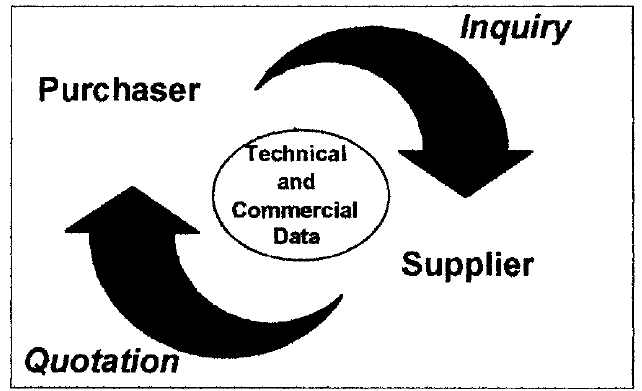
11 SELECTING AND PURCHASING PUMPS 11.31
tained through their entire lifecycle. In this section, the process of selecting and purchas-
ing pumps will be revisited in the context of the way critical information is communicated
between pump purchaser and supplier. Then, four of the emerging information technolo-
gies that are contributing to improved quality and cycle time in the overall process will be
described.
Information Flow Between Purchaser and Supplier Following the decision that
pumping equipment is required, an Inquiry/Proposal process is undertaken involving the
six major steps outlined in this chapter: (1) engineering the pumping system, (2) select-
ing the pump and driver type, (3) pump specification and data sheet preparation, (4)
inquiry and quotation (proposal), (5) evaluate of bids and negotiation, and (6) purchase
the selected pump and driver. The entire process is information intensive, consisting of
both technical and commercial information. The first three steps of the process (steps 1
—
3) are technical in nature, involving the exchange of system design, pump specifications,
and performance and construction details of the pump. The last three steps of the process
(steps 4
—
6) transition toward the commercial elements of the purchasing decision such as
equipment costs, life cycle cost evaluations, terms and conditions, and delivery lead-times.
This flow of technical and commercial information is ascribed by the Inquiry
—
Quotation
information exchange depicted in Figure 9.
This Inquiry
—
Quotation information exchange is not limited to only one purchaser-
supplier interaction. With each new procurement opportunity, this information exchange
effects every trading partner participating in the entire supply chain. Consider the sim-
plified example (in Figure 10) of an Operating Company that gives three Engineering/
Design contractors the opportunity to bid on an expansion of a chemical process plant. If
each of these contractors issues three inquiries to pump manufacturers, nine inquiries are
issued. Now, if each manufacturer issues three inquiries to their sub-suppliers, a total of
27 inquiries are pending for this single plant expansion. In the end, only one contractor,
one equipment-supplier, and one sub-supplier actually receive orders to supply equipment
for the project. Thus, only 3 inquiries out of 27 representing 11% of the total application
and quotation effort represent “useful” work. These engineering costs are recovered only
when equipment is actually purchased. The cost of the other 89% of effort by those partic-
ipants in the Inquiry/Proposal process who did not receive a customer order are “wasted”
FIGURE 9 Purchaser supplier information exchange
